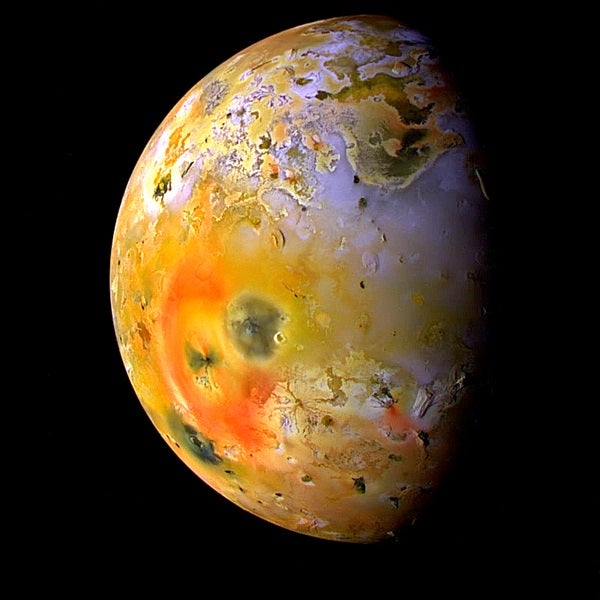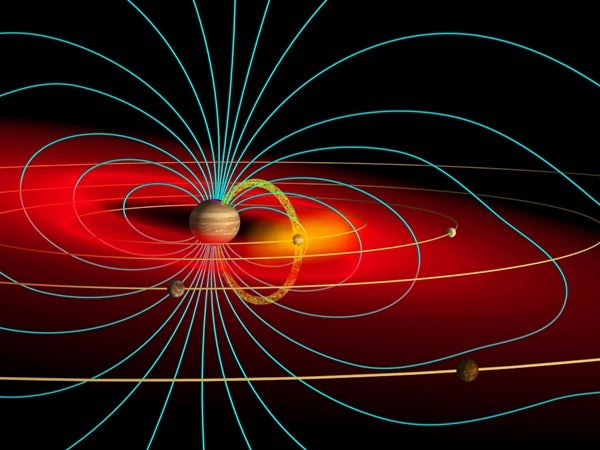The celestial object with the shortest name in the universe also ranks among its most peculiar, and not just because it resembles a pizza with anchovies. Jupiter’s moon Io makes our 50 Weirdest list because it changes the fastest — its surface remakes itself more quickly than any other — and because it’s the most volcanically violent place known anywhere.
More than 100 active volcanoes dot Io’s landscape, and at least a half-dozen are always erupting. If we want to award it with yet another superlative, Io’s surface suffers the highest radiation of any known object, as well.
And yet, no hint of this extreme activity greeted Galileo Galilei on January 8, 1610, when he first laid eyes on Io through his crude, smudgy, 20-power telescope. He soon found that this moon moves so quickly, it visibly changes position in an hour or two. It whizzes completely around Jove in just 13/4 days.

Bringing the universe to your door. We’re excited to announce Astronomy magazine’s new Space and Beyond subscription box – a quarterly adventure, curated with an astronomy-themed collection in every box. Learn More >>.
To appreciate this motion, consider that Io orbits Jupiter at nearly the same distance as the Moon orbits Earth. But while our satellite requires four weeks to complete a circuit, Io does it in 421/2 hours. The explanation, of course, is due to Jupiter’s tremendous mass and gravity, which whips the satellite to an unvarying speed of 38,700 mph (62,300 km/h). This is 25 percent faster than even gas giant Jupiter’s super-fast rotation, whose equatorial speed is some 24 times more rapid than our planet’s.
Io is nearly our Moon’s twin — just 5 percent larger — but no two worlds could be more different. Our Moon’s gray, colorless, unchanging appearance contrasts with Io’s ever-mutating yellows, oranges, and reds — mostly forms of sulfur in various stages of solidification. Io’s most violent eruptions throw umbrella-shaped or fan-shaped red or white plumes around each volcano. Singular explosions can create red rings. In cooler regions, the sulfur solidifies to an odd yellow-green, while cold white sulfur dioxide frost appears nearly everywhere else. No other world we know of looks like Io.
The source for all this subsurface heating and nonstop erupting neither results from the interior decay of radioactive materials, as it does on Earth, nor from toastiness left over from the body’s original formation. Rather, Jupiter’s massive nearby presence and, to a lesser degree, regular interaction with Io’s sister satellite Europa relentlessly stretch and distort Io, creating its Hades-like interior.
This heat releases 100 trillion watts of energy, enough to create the numerous surface hotspots. In addition to the sulfurous and basaltic material colorfully deposited all over Io, eruptions throw a ton of oxygen and sulfur into space each second, where it escapes only to be ionized by the solar wind. These newly chopped-up atoms are promptly captured by Jupiter’s awesome magnetic field, the largest magnetosphere in the solar system.
Here is where additional, curious, violent oddities get cranking. Io orbits within the fiercest field lines of Jupiter’s magnetosphere, which, having captured Io’s ionized atoms of volcanic sulfur and oxygen, accelerate them back and forth between the jovian poles to a frenzied fraction of the speed of light. Io’s orbit constantly carries it through this high-speed subatomic flotsam, its own detritus, whose newly acquired super-velocity bathes the satellite’s surface in an off-the-scale radiation environment that makes Chernobyl seem like a mere tanning salon. Io’s surface radiation level is 3,600 rem per day — five times a lethal human dose. The radiation is strong enough to damage surface materials, darkening them, especially at Io’s poles.
Jove’s magnetic field also connects Io’s super-thin sulfur-and-oxygen atmosphere with Jupiter’s polar clouds, and an electric current called the “Io flux tube” flows between these bodies. This electricity creates an auroral glow on Jupiter, as well as a jovian polar darkening, as high-speed atomic fragments rain down on its clouds. The effect is visible through most backyard telescopes. Through the crudest radio telescopes — even rooftop-based amateur ones — the Io/Jupiter connection produces radio emissions that get louder and quieter depending on Io’s orbital location. These commercial-free broadcasts are at their minimum when Io disappears behind Jupiter.
Together, the Io/Jupiter machine is essentially a pulsar — the nearest to Earth. Traditionally, a pulsar is a neutron star whose magnetic axis is aimed like a lighthouse in our direction, so that a pulse of electromagnetic radiation arrives here with each rotation. But any celestial body or system that sends out perfectly regular energy flashes could also count. Jupiter — modulated by its own spin and by Io’s period of revolution — qualifies.
Io’s surface boasts about 150 mountains, with an average height of 21,000 feet (6,400 meters) and a maximum elevation of nearly 60,000 feet (18,288m). Volcanoes naturally come to mind, but very few of these peaks have such an origin. Instead, Io’s surface compression from its endless tidal distortions pushes these mountains skyward.
With the most multicolored surface in the known universe, outside of Earth’s biosphere, Jupiter’s moon Io is a dramatic, ever-changing showplace. But like fire coral, this beauty almost seems designed to disguise its eternally lethal “dark side.”











